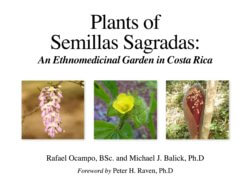We are pleased to announce that our “Big Man” is in full flower, stinking up the rainforest with its indelicate bouquet of rotting flesh. The Big Man, a/k/a Hombron or more scientifically Dracontium gigas, is a confusing plant. It looks like a tree, but it’s really a big stem. It looks solid, but it’s somewhat pliant to the touch and is filled with a honeycomb of soft tissue. Shown below is the tissue of the flower, also revealing the soft honeycomb structure.
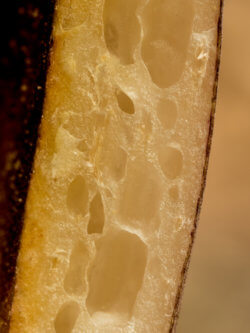
It looks like it’s been in the forest forever, but then it disappears without a trace, only to soon reemerge even bigger and taller. It emerges from what is basically a giant tuber the size of a basketball cut in half. Here’s a 2008 photo from our archives showing the underground structure – and also showing Steven and Tom when they were a little younger!
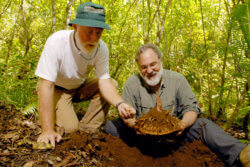
It’s giant flower – some 3-4 feet long and blooming upright, looks lovely but smells like rotten flesh. The odor emitted fills the air of the rainforest, and even meters away you can’t mistake the scent, unpleasant to us but just the ticket for certain pollinators.
. 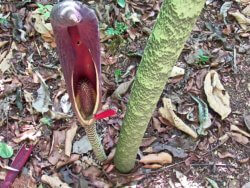
The famed ethnobotanist Rafael Ocampo performed some field surgery on the flower (that’s his knife, above), revealing the reproductive structures of the plant.
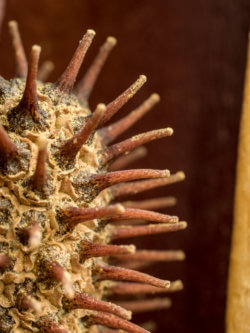
It stem looks like a snake, so indigenous peoples have sometimes used the plant to treat snake bites. While there’s no evidence that this plant has any antivenom properties, using it must have been of some psychological comfort to those bitten by some of the highly venonous snakes in this ecosystem. And it’s growth habit, growing up straight, fast, and hard, must have inspired the imaginations of men who seek this herb as an aphrodisiac. Again, there’s no evidence that it has any chemical properties for that purpose, but as with indigenous peoples the purchasers of today must get some psychological reward.
This recent misuse of the plant has led to the conservation challenge. Men seeking sexual enhancement will pay top dollar for a cousin of this plant that grows in Peru and also now in our Sacred Seeds Sanctuary. This has led to irresponsible wildcrafting that threatens their existence as a species. In response, we’ve collected specimens of Dracontium species and are growing them in our Sacred Seeds Sanctuary. After the plants are established, we take some of them out into the rainforest to help ensure their survival in the wild.
This work is supervised Rafael Ocampo, who is the principal creative force behind Sacred Seeds Sanctuary. The photo below was taken in 2006, the year we founded the sanctuary.

More information about don Rafa and our Sacred Seeds Sanctuary can be found on our website. Tours of the Sacred Seeds Sanctuary are available daily at the lodge.
